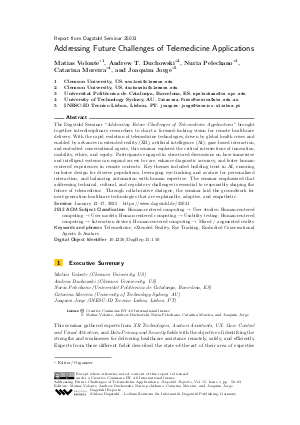Addressing Future Challenges of Telemedicine Applications (Dagstuhl Seminar 25031)
Authors Matias Volonte, Andrew T. Duchowski, Nuria Pelechano, Catarina Moreira, Joaquim Jorge and all authors of the abstracts in this report
-
Part of:
Issue:
Dagstuhl Reports, Volume 15, Issue 1
Part of: Volume: Dagstuhl Reports, Volume 15
Part of: Journal: Dagstuhl Reports (DagRep) - License:
 Creative Commons Attribution 4.0 International license
Creative Commons Attribution 4.0 International license
- Publication Date: 2025-10-02
File

PDF
DagRep.15.1.50.pdf
- Filesize: 1.95 MB
- 34 pages
Document Identifiers
Subject Classification
ACM Subject Classification
- Human-centered computing → User studies
- Human-centered computing → User models
- Human-centered computing → Usability testing
- Human-centered computing → Interaction devices
- Human-centered computing → Mixed / augmented reality
Keywords
- Telemedicine
- eXtended Reality
- Eye Tracking
- Embodied Conversational Agents & Avatars
Metrics
- Access Statistics
-
Total Accesses (updated on a weekly basis)
0PDF Downloads0Metadata Views
Abstract
The Dagstuhl Seminar "Addressing Future Challenges of Telemedicine Applications" brought together interdisciplinary researchers to chart a forward-looking vision for remote healthcare delivery. With the rapid evolution of telemedicine technologies, driven by global health crises and enabled by advances in extended reality (XR), artificial intelligence (AI), gaze-based interaction, and embodied conversational agents, this seminar explored the critical intersections of innovation, usability, ethics, and equity. Participants engaged in structured discussions on how immersive and intelligent systems can expand access to care, enhance diagnostic accuracy, and foster human-centered experiences in remote contexts. Key themes included building trust in AI, ensuring inclusive design for diverse populations, leveraging eye-tracking and avatars for personalized interaction, and balancing automation with human expertise. The seminar emphasized that addressing technical, cultural, and regulatory challenges is essential to responsibly shaping the future of telemedicine. Through collaborative dialogue, the seminar laid the groundwork for next-generation healthcare technologies that are explainable, adaptive, and empathetic.
Cite As Get BibTex
Matias Volonte, Andrew T. Duchowski, Nuria Pelechano, Catarina Moreira, and Joaquim Jorge. Addressing Future Challenges of Telemedicine Applications (Dagstuhl Seminar 25031). In Dagstuhl Reports, Volume 15, Issue 1, pp. 50-83, Schloss Dagstuhl – Leibniz-Zentrum für Informatik (2025)
https://doi.org/10.4230/DagRep.15.1.50
BibTex
@Article{volonte_et_al:DagRep.15.1.50,
author = {Volonte, Matias and Duchowski, Andrew T. and Pelechano, Nuria and Moreira, Catarina and Jorge, Joaquim},
title = {{Addressing Future Challenges of Telemedicine Applications (Dagstuhl Seminar 25031)}},
pages = {50--83},
journal = {Dagstuhl Reports},
ISSN = {2192-5283},
year = {2025},
volume = {15},
number = {1},
editor = {Volonte, Matias and Duchowski, Andrew T. and Pelechano, Nuria and Moreira, Catarina and Jorge, Joaquim},
publisher = {Schloss Dagstuhl -- Leibniz-Zentrum f{\"u}r Informatik},
address = {Dagstuhl, Germany},
URL = {https://drops.dagstuhl.de/entities/document/10.4230/DagRep.15.1.50},
URN = {urn:nbn:de:0030-drops-236765},
doi = {10.4230/DagRep.15.1.50},
annote = {Keywords: Telemedicine, eXtended Reality, Eye Tracking, Embodied Conversational Agents \& Avatars}
}
